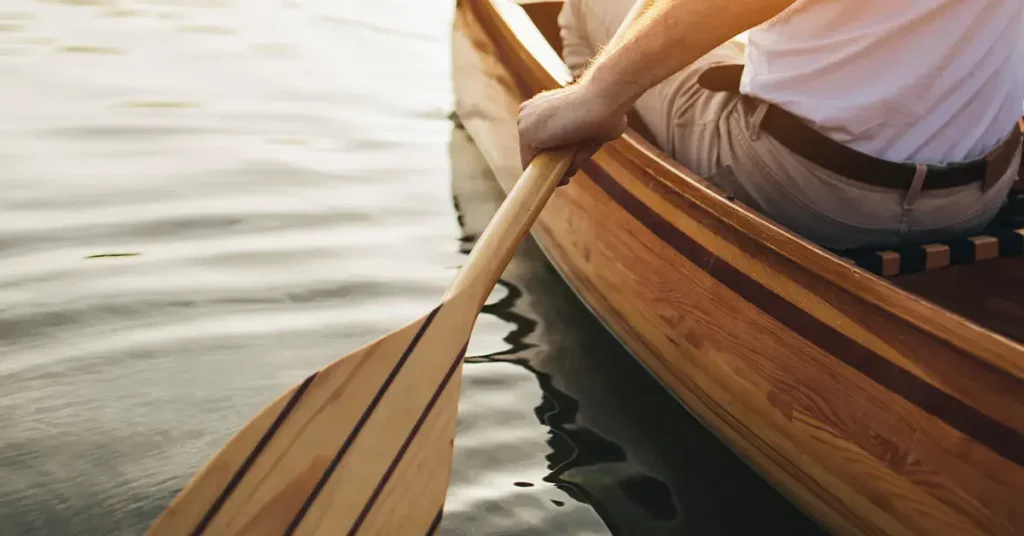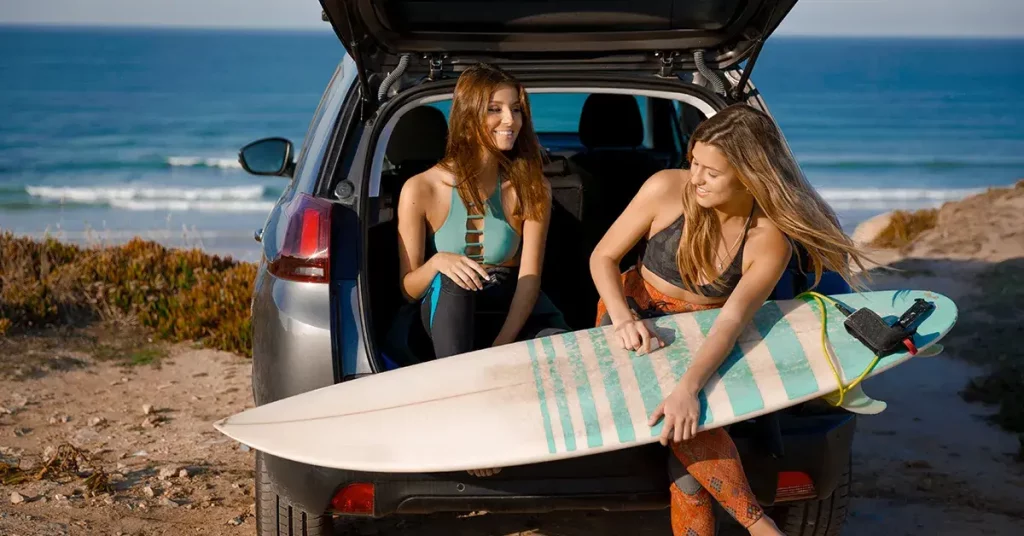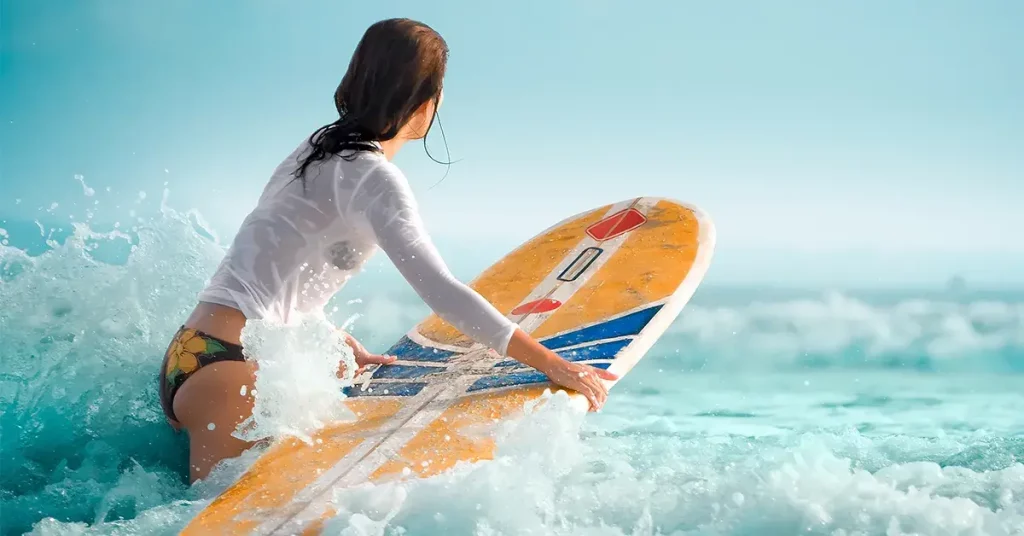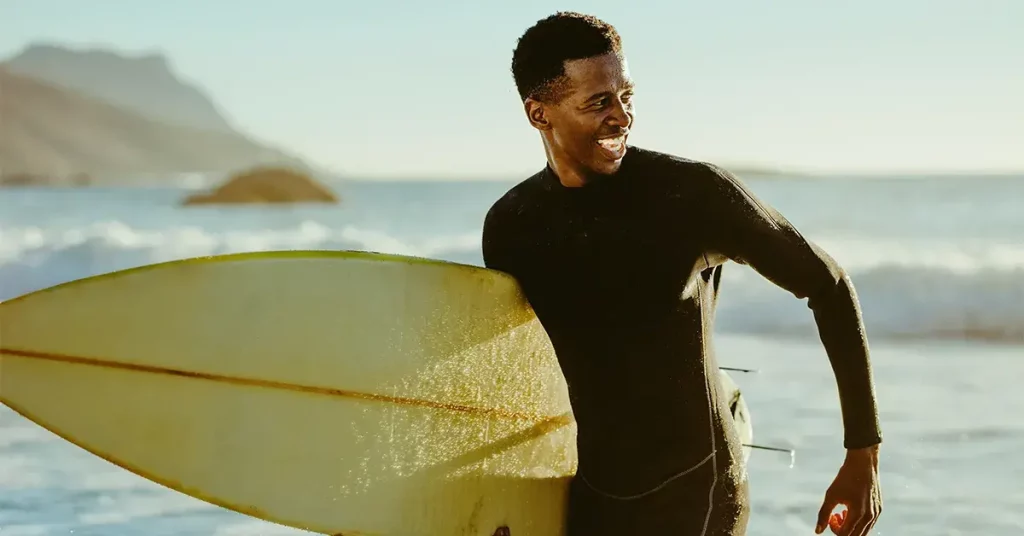While they might not seem like the most important piece of gear, canoe paddles are actually the engine that powers your watercraft. Picking out a high-quality paddle will allow you to comfortably paddle for longer while expending less energy with each stroke.
If you’re like me, you probably never gave much thought to canoe paddles. I grew up canoeing in a beat-up old aluminum canoe with ancient wooden paddles, which worked decently enough.
After getting the chance to test newer composite and layered wood paddles, I’m convinced that investing in a quality paddle is one of the best ways to step up your canoeing game.
The best paddles are made from laminated wood, fiberglass and carbon fiber. Many utilize some combination of the three to provide exceptional performance and durability while keeping the weight down. Cheaper options are often made from aluminum and plastic.
Canoe paddles come in a wide variety of lengths, weights and blade shapes/angles. I’ll break down the various canoe paddle types, review some of the best paddles, and explain how to pick the best one for your needs.
Quick Answer: 6 Best Canoe Paddles
- Best Overall: Bending Branches Beavertail Recreational Canoe Paddle
- Bent Shaft: Bending Branches BB Special Performance
- High Performance: Bending Branches Black Pearl II Carbon
- Plastic / Aluminum: Carlisle Standard Polyethylene Clad Aluminum Paddle
- Budget Pick: Caviness Marine Twin Stripe Paddle
- Hybrid Paddle: Bending Branches Sunburst ST Canoe Paddle
Best Overall: Bending Branches Beavertail Recreational Canoe Paddle
Bending Branches make some of the best paddles on the market today, and this paddle is no exception. Featuring a classic beavertail blade design, it’s ideally suited to deep-water paddling, cruising for long distances and general use. The long and sleek blade design allows for smooth and efficient paddle strokes, which don’t splash when entering and exiting the water.
The blade features Bending Branche’s rockguard technology, protecting the tip from chipping, cracking, and other damage.
The rustic paddle design is aesthetically beautiful, made from durable and buoyant upper Wisconsin Red Alder and Basswood. It weighs in at an impressive 22 oz, making it great for prolonged paddling.
The freestyle palm grip is designed to fit the contours of your palm, making your stroke comfortable and easy to perform.
Key Features
- Available Lengths: 54″, 57″, 60”, 63″
- Weight: Approximately 22 oz
- Beautiful Red Alder and Basswood construction
- Beavertail blade is ideal for deep-water, tripping, and solo use
Bent Shaft: Bending Branches BB Special Performance
If you’re looking for a paddle for flat-water cruising, this bend-shaft paddle makes an excellent choice. The 11° shaft angle allows for a highly efficient stroke, maximizing the power generated while the blade is vertical.
Like other Bending Branch paddles, this paddle looks like a work of art. It’s constructed from multiple hardwood and softwood laminates, including Red Alder, Basswood and Maple. The result is a strong, durable, and lightweight paddle that looks just as good on the water as it does hanging from a cabin wall.
The blade tip is protected by rockguard edge protection, protecting it from cracking, chipping and splitting.
The 54” paddle weighs approximately 22 ounces, although this will vary slightly depending on variances in the wood. This makes it ideal for long-distance padding, as it won’t tire you out like heavier paddles will. The classic palm style grip conforms to the shape of your palm enabling comfortable cruising.
Key Features
- Available lengths: 48”, 50”, 52”, 54”, 56”
- Weight: Approximately 22 oz
- 11° shaft angle is ideal for efficient flat-water cruising
- The blade is constructed from 7-laminate Red Alder, Basswood, and Maple
View Pricing On:
High Performance: Bending Branches Black Pearl II Carbon
If maximum performance is what you’re after, the Bending Branches Pearl II is an excellent option. It’s ultra-light – weighing just 16 ounces – making it one of the lightest paddles on the market. A foam core blade helps to keep the weight down while maintaining its durability.
The entire paddle is constructed from carbon fiber including the grip, shaft, and blade. The jet-black carbon design blends the old with the new, and looks amazing both in and out of the water.
The blade is nylon-weave reinforced, ensuring it’s protected from years of abuse around rocks and other rough conditions. An 11° blade angle makes flat-water paddling a breeze, while the contoured palm grip fits perfectly in the palm of your hand.
While it costs significantly more than other paddles – the longevity, performance, and durability more than justify the price tag.
View on: [su_button url=”https://www.amazon.com/Bending-Branches-Black-Carbon-Paddle-52in/dp/B0766M2QCG/ref=as_li_ss_tl?ie=UTF8&linkCode=ll1&tag=coastalside-20&linkId=66ca0053b4983c8b97d498ec702e1649&language=en_US” target=”blank” style=”flat” background=”#d93f2c” size=”8″ radius=”5″ text_shadow=”0px 0px 0px #000000″]Amazon[/su_button] | [su_button url=”https://www.avantlink.com/click.php?tt=el&merchant_id=95f93ecc-b5f1-436c-9c8b-0c48826bb3ff&website_id=fa8ead2b-1363-4b1f-bb72-fdc0af99c59f&url=https%3A%2F%2Fwww.outdoorplay.com%2Fbending-branches-black-pearl-II-canoe-paddle%3Fcustcol_length%3D30″ target=”blank” style=”flat” background=”#d93f2c” size=”8″ radius=”5″ text_shadow=”0px 0px 0px #000000″]Outdoorplay[/su_button]
Key Features
- Available lengths: 48”, 50”, 52”, 54”, 56”
- Weight: 16 ounces
- All carbon construction offers high-level performance and durability
- 11° blade angle is highly effective and efficient for flat-water padding
- All black carbon design is visually striking
View Pricing On:
Plastic / Aluminum Paddle: Carlisle Standard Polyethylene Clad Aluminum Paddle
Tough, rugged and ready for action, this vinyl-clad aluminum and polyethylene paddle works well in a wide variety of paddling environments. The aluminum shaft is coated in a vinyl – providing a comfortable grip for prolonged use.
The T-grip and blade are constructed from durable and UV-resistant synthetics, making it ideal for use in rough, rocky environments. The 60” model weighs 34 ounces, making it slightly heavier than other materials, but still light enough that you won’t tire out quickly while using it.
A T-grip handle offers a high degree of control and maneuverability, but may not be as comfortable as palm-style grips for prolonged paddling sessions.
Whether you plan to use it as a backup or primary paddle, the Carlisle Standard makes a great choice, especially in this price range.
Key Features
- Available lengths: 54”, 57”, 60”, 63”
- Weight: 34 oz. (60” model)
- Durable, tough-as-nails aluminum and polyethylene construction
- Excellent value for the price
View Pricing On:
Budget Pick: Caviness Marine Twin Stripe Paddle
If you’re looking for a basic paddle without breaking the bank, then this all-wood paddle from Caviness fits the bill nicely. It features a wedge insert which strengthens the tip of the paddle for pushing off rocks or the shore.
The fit and finish are not as nice as some of the more expensive wood paddles, but for the price, it’s more than adequate. If you want to upgrade the factory coating, a quick sanding and coat of varnish will ensure it’s well protected from the elements.
Weighing in at just 24 oz. for the 5-foot model, it’s on the lighter side as far as wood paddles go. This makes it ideal for longer trips and prolonged paddling.
The twin stripe blade design is both attractive and functional, while the oval-shaped shaft is comfortable to hold for hours at a time.
Key Features
- Available lengths: 5’, 4’, 4.5’, 5’, 5.5’, 6’
- Weight: 24 oz. (5-foot model)
- Well-made, lightweight and functional
- Excellent value
View Pricing On:
Hybrid Paddle: Bending Branches Sunburst ST Canoe Paddle
Blending the old with the new, this carbon and laminated wood paddle from Bending Branches offers peak performance and striking beauty. The laminated wood blade is constructed from a blend of Red Alder, Basswood, and Roasted Basswood, and is coated in protective fiberglass. The blade features a 2 oz fiberglass wrap around the entire blade tip, protecting it from any accidental damage.
The unique wood grip is a blend of a traditional palm grip and a T-grip, providing the best of both worlds when it comes to paddle control. It’s comfortable, easy to hold, and gives a warm feeling in hand.
The shaft is constructed from lightweight and powerful T-700 carbon, similar to materials used in the aerospace industry. These cutting-edge materials keep the entire weight to just 17 ounces, making it one of the lightest paddles on the market.
View on: [su_button url=”https://www.amazon.com/Bending-Branches-Sunburst-Canoe-Paddle/dp/B0073QS2PO/ref=as_li_ss_tl?ie=UTF8&linkCode=ll1&tag=coastalside-20&linkId=4525990896bf9a76b39edf24ab1e8263&language=en_US” target=”blank” style=”flat” background=”#d93f2c” size=”8″ radius=”5″ text_shadow=”0px 0px 0px #000000″]Amazon[/su_button] | [su_button url=”https://www.avantlink.com/click.php?tt=app&ti=1019&mi=10248&pw=269549&url=https%3A%2F%2Fwww.rei.com%2Fproduct%2F173351%2Fbending-branches-sunburst-st-canoe-paddle” target=”blank” style=”flat” background=”#d93f2c” size=”8″ radius=”5″ text_shadow=”0px 0px 0px #000000″]REI[/su_button]
Key Features
- Available lengths: 52”, 54”, 56”, 58”, 60”
- Weight: 17 oz. (54” model)
- The visually striking design looks great on and off the water
- Combination of carbon, laminated wood, and fiberglass
View Pricing On:
How to pick the best canoe paddle
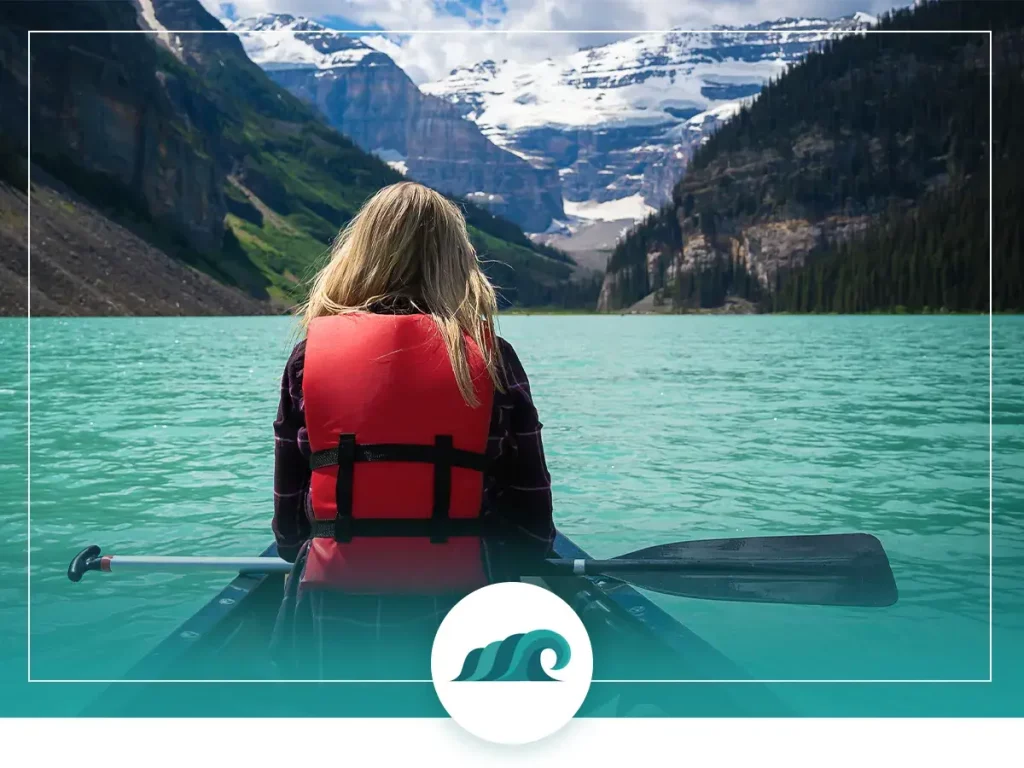
With all the paddle materials, shapes, and sizes out there, picking the right canoe paddle for your needs can seem like a daunting task. I’ll break down the important factors you need to consider when picking out a paddle.
Blade shape
The blade shape is an important consideration when picking out a canoe paddle.
Larger blades offer better propulsion and power but require more effort to paddle with. They’ll “bite” into the water more effectively than smaller paddles. You’ll tire yourself out faster paddling a larger blade than a slimmer one. This makes larger blades ideal for whitewater and paddling in strong current.
Smaller blades require less effort with each stroke but have less power and propulsion ability. These paddles are great for calmer lakes and rivers, where you don’t need to fight against strong current or wind. Their slim profile also means they won’t catch the wind the same way a larger blade does.
Common blade shapes:
Beavertail blades are long and slim and make excellent general use or canoe tripping paddles. These classic blades are slim and rounded, shaped like a beaver’s tail. The blade itself is long, which helps with deep water paddling and sweep strokes.
Ottertail blades are similar to beavertails but are narrower and more rounded towards the tip. They’re great for solo paddling, tripping, and deep-water use.
Both beavertail and ottertail blades allow for a quick, efficient stroke. Their rounded tips easily enter and exit the water without splashing, which makes them ideal for paddling in calmer conditions and getting close to wildlife without spooking them. This makes them ideal for canoe fishing.
Also, because they’re narrow towards the blade top, you can paddle close to the side of the canoe.
Teardrop shaped paddles are used with bent-shaft paddles. These blades enable you to paddle effectively in shallower water and provides a shorter, more efficient stroke. These paddles are the preferred choice for most marathon racers and are often made from high-end materials like carbon fiber and fiberglass.
Square tipped blades are wide and designed to provide maximum power and propulsion in whitewater and strong current. They’re not particularly efficient in the water and will tire you out if you paddle with them for prolonged periods. The square tip will splash as it enters and exits the water, making them less effective for calm water paddling.
Length
Paddle length can refer to several things, but the most important consideration is shaft length. This refers to the shaft length only, not the entire paddle including the blade.
The shaft length should be roughly equal to the distance from your shoulder to the water when you’re seated inside a canoe.
This can be measured in several ways:
- With a paddle: Kneel down with your bottom about 6” off the ground. Hold the paddle upside down, with the grip on the floor. The shaft end should line up roughly with your nose.
- Without a paddle: Kneel down with your bottom 6” off the ground. Measure the distance between your nose and the ground. This is your ideal shaft length.
When buying a paddle, add the length of the blade (often 20”) to the shaft length calculated above. This is your ideal overall paddle length. Paddles are commonly sold in 3” increments, so round up or down to the nearest length.
If you’re planning to paddle solo or your canoe is on the wider side, add an extra 2” or so.
Check out this video for a quick look at canoe paddle sizing:
Materials
When it comes to paddle materials, you’ll have a hard time beating the form and function of a classic wood paddle. Wood is not only light and aesthetically pleasing, it just feels right in your hand. Compared to the artificial feeling of plastic or aluminum, wood has an inherent warmth that puts a smile on your face.
Wood paddles are either a solid piece or laminated. Newer paddles often utilize a combination of woods, laminating both hardwood and softwood together, to create a lightweight and durable fusion. Lighter wood is often used for the core, while a heavier, durable wood is used around the edges.
While wood paddles are fairly lightweight – with higher-end models coming in at less than a pound – they’ll never be quite as light as carbon fiber. Wood also requires occasional upkeep to keep it in top shape, including occasional varnishing and sanding/refinishing in case of damage.
Composite paddles include fiberglass and carbon fiber. Fiberglass is somewhat rare outside of canoe racing and stand up paddleboarding.
Carbon fiber paddles are ultra-light, durable and virtually maintenance-free. While these paddles offer high-end performance, they cost a pretty penny.
Plastic and aluminum paddles are the least expensive material – but offer the worst overall performance. Plastic is typically used for the blade and grip, while the shaft is made from aluminum. These paddles are durable, low-maintenance and affordable. While I wouldn’t recommend plastic/aluminum for your main paddle, they do work well as a secondary paddle or backup for a trolling motor.
Weight
Weight is another key consideration when picking out a paddle. In general, the lighter your paddle is the better.
This is especially true for long treks or canoe camping. A lighter paddle will allow you to paddle for prolonged periods without tiring yourself out.
Typical wood canoe paddles weigh in at approximately 20 – 24 oz, although lighter ones are available. Plastic and aluminum paddles are significantly heavier, typically weighing 30 oz or more. The lightest paddles are made from fiberglass and carbon fiber, which can weigh in at less than a pound.
Bent vs. Straight Shaft
This one comes down to personal preference. Traditional straight shaft canoe paddles are versatile and perform well in a variety of conditions including rivers, whitewater, and general cruising.
Bent shaft paddles are intended for flat water cruising, as their design maximizes stroke efficiency. The angled blade results in a shorter, powerful stroke that keeps the blade vertical during the most powerful portion of the stroke.
If you’re only getting one paddle, I’d recommend going with a straight blade for general use. You can also get multiple paddles for different use cases (one for cruising, and one for steering/bracing).
Reinforced Blade Tip
A tough, reinforced blade tip is an important feature to look for in a canoe paddle. This is especially important when paddling in shallow, rocky waters.
Many wood paddles come with a fiberglass or lacquer coating surrounding the blade tip, which protects it from damage. This means you can push off rocks without worrying about damaging the blade. If you’re planning to paddle in seriously rocky environments, looks for a blade with rock protection around the entire edge.
Plastic and composite blades are inherently durable and can withstand a fair bit of abuse without damage.
Grip
While it might not seem that important, a paddle’s grip acts as the contact point between your palm and the fulcrum formed by your paddle. A solid, comfortable grip will enable you to paddle comfortably for longer, without discomfort or pain in your wrists.
There are two main grip types found in canoe paddles – palm grips and T-grips.
Palm grips are fan-shaped, ergonomic grips meant to conform to the shape of your palm. They’re comfortable, feel solid in your hand, and are perfect for longer, casual paddling.
T-shaped grips offer the highest degree of control over your paddle. Steering and bracing maneuvers are easier to perform with a T-grip.
Price
When it comes to canoe paddles, you get what you pay for. Sure, you can go with a cheap plastic and aluminum paddle, but your paddling performance will suffer.
A well-made wood paddle is not just an efficient and effective means of propulsion. Many are absolutely beautiful – and look great mounted on your wall. A good paddle will make you want to get out and paddle more often!
If you’re an experienced paddler or you’re looking for absolute peak performance, then a composite paddle makes an excellent choice. While they’re not cheap, they’re ultra-light and durable and will last for years to come.
If you paddle in heavy current or white water, then a paddle leash will help prevent losing your paddle.

